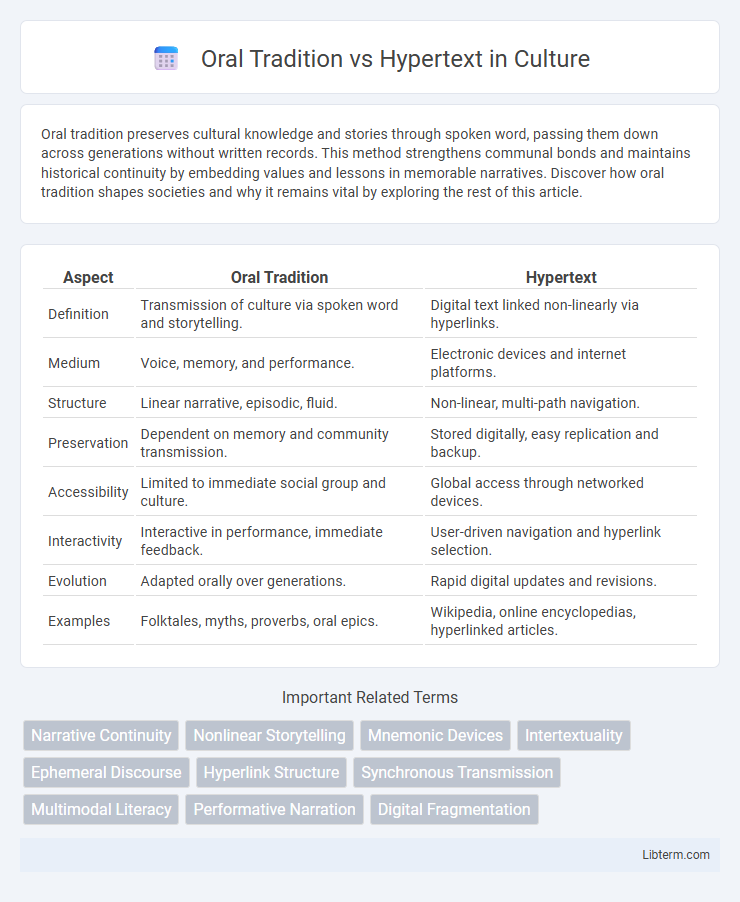Oral tradition preserves cultural knowledge and stories through spoken word, passing them down across generations without written records. This method strengthens communal bonds and maintains historical continuity by embedding values and lessons in memorable narratives. Discover how oral tradition shapes societies and why it remains vital by exploring the rest of this article.
Table of Comparison
| Aspect | Oral Tradition | Hypertext |
|---|---|---|
| Definition | Transmission of culture via spoken word and storytelling. | Digital text linked non-linearly via hyperlinks. |
| Medium | Voice, memory, and performance. | Electronic devices and internet platforms. |
| Structure | Linear narrative, episodic, fluid. | Non-linear, multi-path navigation. |
| Preservation | Dependent on memory and community transmission. | Stored digitally, easy replication and backup. |
| Accessibility | Limited to immediate social group and culture. | Global access through networked devices. |
| Interactivity | Interactive in performance, immediate feedback. | User-driven navigation and hyperlink selection. |
| Evolution | Adapted orally over generations. | Rapid digital updates and revisions. |
| Examples | Folktales, myths, proverbs, oral epics. | Wikipedia, online encyclopedias, hyperlinked articles. |
Defining Oral Tradition and Hypertext
Oral tradition refers to the ancient practice of transmitting stories, history, and cultural knowledge verbally across generations, emphasizing memory, performance, and communal participation. Hypertext is a digital system that organizes information through interconnected nodes or links, allowing nonlinear navigation and immediate access to related content. While oral tradition relies on human interaction and sequential storytelling, hypertext enables dynamic, user-driven exploration of textual information.
Historical Contexts and Evolution
Oral tradition, rooted in prehistoric human societies, preserved knowledge through spoken stories, rituals, and songs, forming the foundation of cultural identity before written language emerged around 3200 BCE in Mesopotamia. Hypertext, developed in the 1960s with Ted Nelson's concept and popularized by Tim Berners-Lee's World Wide Web in 1989, transformed information dissemination by enabling non-linear, interconnected digital texts. This evolution reflects a shift from memory-dependent storytelling in communal settings to dynamic, user-driven navigation of linked content in digital environments, highlighting changes in how knowledge is produced, stored, and accessed across history.
Modes of Narrative Transmission
Oral tradition relies on spoken language and memory to transmit stories, emphasizing communal participation, voice modulation, and cultural context to preserve narratives. Hypertext uses digital links and interactive structures, enabling non-linear navigation and user-driven exploration of content within a networked text environment. The modes of narrative transmission in oral tradition are inherently performative and dynamic, whereas hypertext offers customizable pathways that reshape reader engagement and knowledge construction.
Community Participation and Authorship
Oral tradition thrives on active community participation, where stories evolve through collective memory and shared narration, enabling a communal authorship that reflects diverse voices and cultural values. Hypertext facilitates interactive authorship by allowing users to contribute, modify, and link content dynamically, fostering a decentralized community engagement through digital networks. Both forms emphasize participatory storytelling but differ in medium and collaborative structure, with oral tradition rooted in verbal exchange and hypertext in interconnected digital platforms.
Memory, Preservation, and Loss
Oral tradition relies on collective memory and repetition to preserve stories, rituals, and knowledge across generations, but it is vulnerable to distortion and loss as details may change over time. Hypertext enhances preservation by offering a non-linear, easily accessible digital repository that supports detailed cross-referencing, reducing the risk of information fragmentation. While oral tradition depends on human memory and social interaction, hypertext ensures long-term retention and retrieval through digital storage and linking structures.
Interactivity in Storytelling
Interactivity in storytelling transforms oral tradition by replacing passive listening with active participation, enabling audiences to influence narrative flow. Hypertext storytelling leverages digital links and user choices, creating nonlinear experiences that mirror the communal dynamics of oral traditions. This fusion enhances engagement by allowing stories to evolve dynamically based on individual interactions and decisions.
Structure: Linear vs Nonlinear Narratives
Oral tradition relies on a linear narrative structure where stories are passed sequentially through generations, emphasizing memory and repetition. Hypertext, by contrast, employs a nonlinear narrative allowing readers to navigate content through hyperlinks, creating personalized pathways and multiple story outcomes. This structural difference transforms the engagement and interpretation of information between linear oral storytelling and dynamic hypertext environments.
Accessibility and Inclusivity
Oral tradition fosters accessibility through its reliance on spoken language, making cultural narratives available to communities regardless of literacy levels or technological access. Hypertext enhances inclusivity by enabling nonlinear navigation of information and multimodal content, catering to diverse learning preferences and abilities. Both methods support knowledge sharing, yet oral tradition excels in communal bonding and memory transmission while hypertext offers personalized, interactive engagement.
Cultural Impact and Transformation
Oral tradition preserves cultural narratives through spoken word, fostering communal identity and intergenerational memory. Hypertext revolutionizes cultural transmission by enabling nonlinear exploration and dynamic reinterpretation of stories, expanding accessibility globally. The transformation from oral to digital hypertext reshapes cultural engagement, allowing interactive participation and the fusion of diverse cultural perspectives in contemporary storytelling.
Future Prospects and Hybrid Forms
Future prospects in storytelling encompass the fusion of Oral Tradition's narrative depth with Hypertext's interactive capabilities, creating immersive hybrid forms that enhance user engagement. These hybrid systems leverage multimedia elements and nonlinear pathways to preserve cultural nuances while offering personalized narrative experiences. Integrating AI-driven content adaptation further refines this synergy, promising dynamic, context-aware storytelling that bridges ancient practices with digital innovation.
Oral Tradition Infographic

 libterm.com
libterm.com